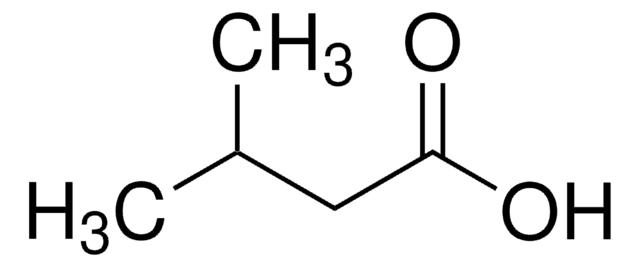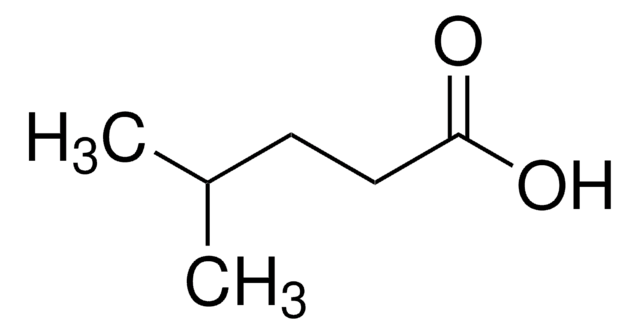21529
Hexanoic acid
analytical standard
Synonyme(s) :
Acid C6, Caproic acid
About This Item
Produits recommandés
Qualité
analytical standard
Niveau de qualité
Densité de vapeur
4 (vs air)
Pression de vapeur
0.18 mmHg ( 20 °C)
Pureté
≥99.0% (GC)
Durée de conservation
limited shelf life, expiry date on the label
Technique(s)
HPLC: suitable
gas chromatography (GC): suitable
Indice de réfraction
n20/D 1.416
n20/D 1.4161 (lit.)
Point d'ébullition
202-203 °C (lit.)
Pf
−4 °C (lit.)
Densité
0.927 g/mL at 25 °C (lit.)
Application(s)
cleaning products
cosmetics
environmental
flavors and fragrances
food and beverages
personal care
Format
neat
Propriétés organoleptiques
pungent
Chaîne SMILES
CCCCCC(O)=O
InChI
1S/C6H12O2/c1-2-3-4-5-6(7)8/h2-5H2,1H3,(H,7,8)
Clé InChI
FUZZWVXGSFPDMH-UHFFFAOYSA-N
Vous recherchez des produits similaires ? Visite Guide de comparaison des produits
Description générale
Find all available reference materials for compounds listed in 10/2011 here
Application
- In Dortyol yerli orange juices by high performance liquid chromatography method
- In Lomatogonium rotatum, a herbal medicine sample using acridone-9-ethyl-p-toluenesulfonate (AETS) as a fluorescence derivatization reagent by high performance liquid chromatography (HPLC).
Produits recommandés
Mention d'avertissement
Danger
Mentions de danger
Classification des risques
Eye Dam. 1 - Skin Corr. 1C
Code de la classe de stockage
8A - Combustible corrosive hazardous materials
Classe de danger pour l'eau (WGK)
WGK 1
Point d'éclair (°F)
215.6 °F - closed cup
Point d'éclair (°C)
102 °C - closed cup
Équipement de protection individuelle
Faceshields, Gloves, Goggles, type ABEK (EN14387) respirator filter
Faites votre choix parmi les versions les plus récentes :
Déjà en possession de ce produit ?
Retrouvez la documentation relative aux produits que vous avez récemment achetés dans la Bibliothèque de documents.
Les clients ont également consulté
Protocoles
In this study, SPME was used for the analysis of free fatty acids in Parmesan cheese using a 65 μm Carbowax/divinylbenzene (DVB) SPME fiber. Headspace extraction of the cheese sample was conducted at 65 °C for 15 minutes and analyzed by GC with FID detection. SPME is ideal for analyzing the volatiles associated with solid food samples. The phase chemistry of the Nukol GC column provides excellent peak shape of acidic compounds.
Notre équipe de scientifiques dispose d'une expérience dans tous les secteurs de la recherche, notamment en sciences de la vie, science des matériaux, synthèse chimique, chromatographie, analyse et dans de nombreux autres domaines..
Contacter notre Service technique










